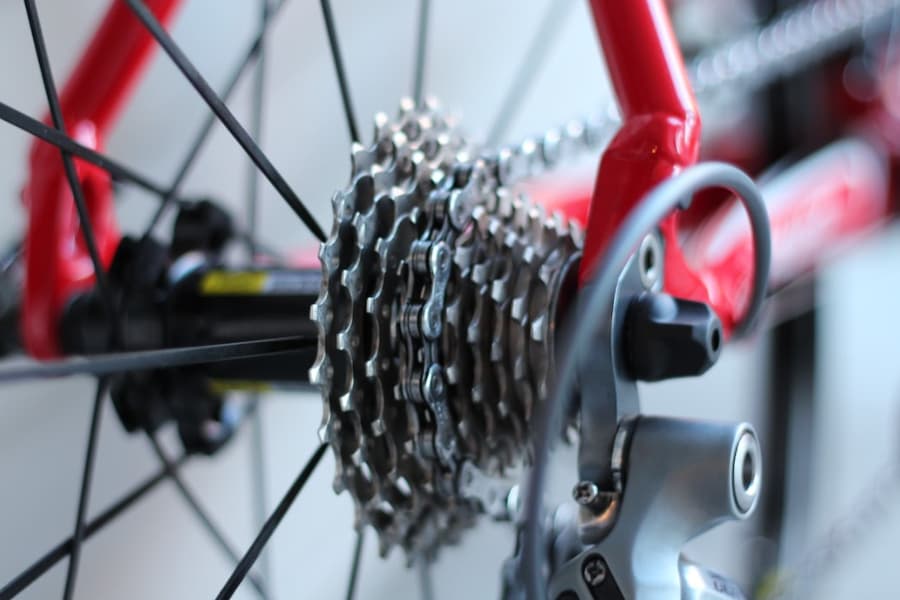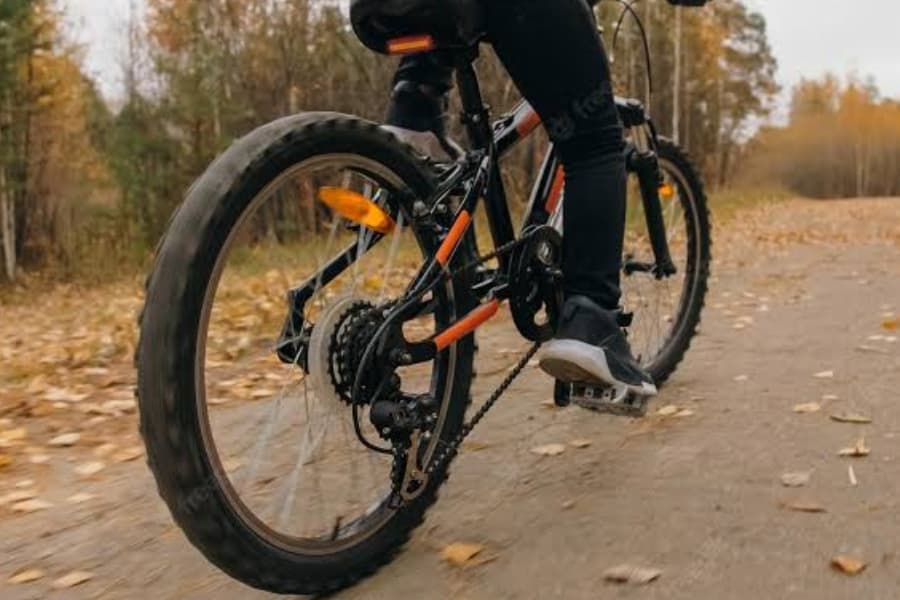The distinctions between a geared and non-geared cycle often need to be clarified. As the name implies, geared cycles are bicycles having a number of gears that might vary from model to model. Cycles without gears or shifters are known as gearless cycles. That’s just a primary difference between a gear cycle vs gearless cycle.
What is Gear Cycle?
The suspension and fork are just two of the many components that jointly define the kind of cycle. As the name suggests, Gear cycles are cycles that have gears in them. Gear cycles let you combine the gears in a variety of ways.
With lower gears, you can ride more quickly when cycling uphill without wearing out your legs. Similar to this, you can pedal more quickly and easily if you’re cycling on a flat surface while using higher gear ratios.



You will have gears whether you ride a road bike, mountain bike, or pretty much any other type of bike.
Tru Bike has a wide range of gearless as well as gear cycles in case you’re looking for an enhanced riding experience for your Lil ones.
They are the mechanical marvels that let you accelerate over flat, smooth roads at wind-whistling speeds or push your way up a steep, rocky climb without passing out..
Understanding a gear cycle.
A gear cycle, commonly referred to as a multi-speed or geared bicycle, is made up of many essential parts that function in concert to let the rider change gears. It’s important to understand the gear combination in a cycle.
What are the key components of a gear-shifting cycle?
The key components of a gear-shifting cycle include:
- Rear wheel gears or cogs:
These are the gears that the chain travels through. They are available in various sizes and tooth counts.
- Chain:
The link securing the pedals to the back wheel is the chain. On the back wheel, it passes over the cogs or gears.
- Derailleur:
The device that shifts the chain between gears is known as a derailleur. The shifters are in charge of it.
- Shifters:
The rider utilizes the shifters, which are levers, to control the derailleur. Typically, they are found on the handlebars.
What is the use of gear in a cycle?
Gears are parts or components of a cycle that helps us to ride swiftly. Gears help you ride more quickly. Speed is necessary while climbing inclines. However, if we have a single-speed cycle commonly known as a gearless cycle, it will be a complicated task. But higher gear can help with minimum effort if you want to move quickly.
To boost the speed, one must depend on gears. You should also be aware of the terrain if you wanna use the gears effectively. Typically, geared cycles are used on hilly terrain which keeps on changing in nature, hence it’s important to not only know your gears but also the terrain where you’re riding.
Tru Bike’s Tru 2.0 Pro Gear cycles are ultralight and innovative bikes for all round use by children aged between 6-8 years.



Advantages of Gear Cycles:
- Geared cycles allow full control: Geared bicycles have the benefit of allowing you to adjust the gearing to suit several terrains, making all of your rides more fascinating. You’ve full control over the speed. This means total control.
- Geared cycles can speed up pretty quickly:If you’re looking to accelerate more quickly, the gear cycle is your go-to option. You can alter the speed by simply switching the gears. How easy is that!
- Gear bikes can help you enjoy cycling on a variety of terrain:Gear bikes can take you on longer, more challenging routes since they cover more ground without tiring you. If you enjoy cycling uphill, these cycles are ideal because they make the activity much easier and fun. Be it a biking expedition or riding on hilly terrain, with a gear cycle, you’re good to go.
- Gear cycles are created to fit our exact needs: Be it a flat road or an incline, Gear cycles are perfect for any scenario. In case you stumble upon an inclined surface all of a sudden, on a gearless bike, you would typically need to charge yourself up and exert extra effort to pass that road. But in the case of a gear cycle, all you have to do is adjust the gear as required.
- Gear cycles are the best option for elderly people and kids.Gear cycles help us to make our actions smoother and cycling on hills becomes easier on bicycles. Additionally, it is most effective for kids, elderly people and people with various physical conditions that prevent them from engaging in vigorous physical activity.
How does the gear shifting or gear combination in cycles work?
The simpler it is to pedal, the more teeth a gear has; the harder it is to pedal, the fewer teeth. The difficulty of pedaling changes when the rider changes gears since they are shifting the chain from one gear to another.
The range of gears on the rear that can be used successfully is determined by the front gear, which works in conjunction with the back gear.
It’s crucial to remember that the front gear, known as a chainring, is operated by the left shifter and has fewer teeth than the gears in the back. The right shifter controls the sprockets, or gears, on the back of the vehicle.
That’s all for the gear combination in cycles.
How to shift gears in a gear-shifting cycle?
Before shifting gears, it’s important to select the right gear for the terrain and riding conditions. The gear combination in cycles can be tricky to change. These tips would come in handy.
Also, you can refer here to check out Tru Bike’s blog to get insights on how to teach your kids to ride.
Following are the tips to select the right gears while gear shifting in cycles.
What are the tips for selecting the right gear?
- Selecting the Right Gear for the Terrain:
It’s crucial to choose the appropriate equipment for the terrain and riding circumstances. A higher gear will be more effective on flat or downhill terrain, whereas a lower gear will make pedaling simpler when going uphill. When choosing a piece of equipment, it’s crucial to take the rider’s own fitness level and riding style into account.
- Shift Gears before a Hill or Acceleration:
It is advisable to change gears before a hill, not while climbing, and before accelerating, not while doing so. This will smooth out the gear transition and guard against tangles and damage to the chain.
Why is it important to pedal at the right time while shifting gears in a gear-shifting cycle?
It’s crucial to pedal at the appropriate moment when changing gears to guarantee a seamless transition and avoid damaging or catching the chain. It is better to change gears when the rider is pedaling steadily, not when they are exerting extra effort to climb a hill or accelerate quickly.
Before the rider starts to pedal more forcefully, this will allow the derailleur ample time to adapt the chain position to the new gear. When shifting gears, avoid any unexpected jerks or resistance by timing your pedaling to prevent damaging the chain or derailleur.
Step-by-step instructions: Learn how to shift gears through step-by-step instructions.
- Choose the gear you wish to change into to start.
- Make sure you’re cycling steadily while applying light pressure.
- To shift the left shifter, use your left hand; to shift the right shifter, use your right hand.
- When you hear or feel a click, the gear has been changed. Gently turn the shifter.
- Make any required adjustments to your speed and level of difficulty as you continue to pedal.
How to transition smoothly between shifting gears in a gear combination cycle?
- Start small:
Instead of attempting to change too many gears at once, it is crucial to shift gears gradually to provide a seamless transition between them.
- Practice a lot:
Practicing gear changes while riding at various speeds and across various terrains is also beneficial.
- Listen to the gear combination cycle’s bike parts noise:
It’s also crucial to pay attention to any unexpected noises or resistance coming from your bike since these could be signs that the chain is not properly positioned on the gears.
What are the common mistakes made when shifting gears in gear cycles?
- Shifting too quickly:
Too rapidly or abruptly changing gears is one common mistake. A jerky ride or damage to the chain or derailleur could come from the chain jumping or getting snagged as a result of this.
- Not pedaling at the right time:
A jerky ride or damage to the chain or derailleur might arise from another frequent error, which is not pedaling at the appropriate moment when changing gears, as was covered earlier in the guide.
- Not adjusting gears to match the terrain:
Another common error is not changing the gears to meet the terrain and riding circumstances. This may lead to an inefficient ride where the cyclist uses excessive energy to maintain a particular speed or insufficient energy to navigate a particular terrain.
How to avoid these mistakes when shifting gears in a gear combination cycle?
- Practice makes the difference:
Children who practice shifting gears confidently and smoothly will be able to ride for extended lengths of time and over a variety of terrain. Children can learn the skill of gear shifting over time if they are persistent and patient, so they can fully appreciate their ride.
- Match the gears to the terrain:
It’s crucial to always adapt the equipment to the terrain and riding circumstances; doing so will guarantee that the rider is using the appropriate amount of energy for the task at hand. This can be achieved by observing the terrain and choosing the correct gear before a hill or when accelerating.
- Shift the gears gradually:
It’s crucial to practice shifting gears and pay attention to how your bike feels and sounds while you do so in order to avoid making these errors. It’s also beneficial to take the time to smoothly and gradually change gears before a ride. The chain will shift smoothly between gears and the derailleur will have time to correct the chain position before the rider starts to pedal more vigorously.
When learning to ride a gear cycle, kids must develop the ability to shift gears. Children who practice shifting gears confidently and smoothly will be able to ride for extended lengths of time and over a variety of terrain.
Children can learn the skill of gear shifting over time if they are persistent and patient, so they can fully appreciate their ride. Make sure to check Tru Bike Tru 2.0 Pro Gear Cycle for Kids 6 to 8-year-Old, one of the best gear cycle experiences for your kids. Happy cycling! Ride and shine!!!
When you first look at it, you’ll find that the gear system seems tricky. However, let us assure you that with a little practice and an understanding of the roads you can ace it. Whenever you’re looking to purchase a gear cycle, keep in mind your riding style and your frequently used terrain. This decision will come in handy. Also, taking care of your gear bike is non-negotiable.
Now that all of your concerns have been resolved, and you know what does gear do in cycle, you can start cycling! Super light, super safe, ergonomic and designed for kids, Tru Bike has a wide range of gear cycles. Head here to shop now. In case you have any queries, contact Tru Bike for further assistance and personalized advice.








